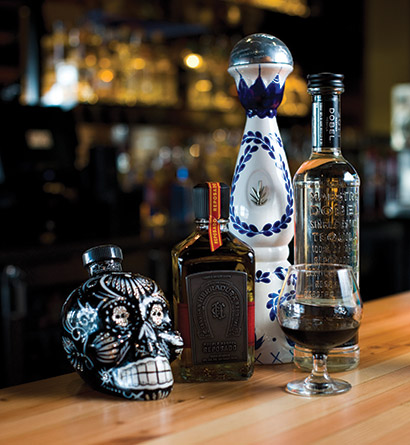If you think of “Mexican food” as a greasy cheese bomb—albeit a yummy one—it’s time to wake up and smell the cilantro. You might credit the advent of popular nuevo latino cuisine, especially Mexican, to Chicago chef and restaurateur Rick Bayless, who took it upon himself to bring “real Mexican food” north of the border. Real food means fresh fruits and veggies, vibrant salsas, peppers in every shape and hue, delicate herbs and a range of spices. He revolutionized the way Americans eat: Now it’s as easy to buy fresh pico de gallo at your run-of-the-mill supermarket as it is to get cornflakes. People know what queso, quesadillas and tamales are, and they love it all.
The Twin Cities has its own trajectory within the nuevo latino story arc. Our earliest Mexican success scenario belongs to Marno McDermott, of Irish-Scandinavian descent, who opened the wildly popular Chi Chi’s in 1975 in Richfield. Chi Chi’s grew to a chain of more than 250 locations and continues to churn out tacos in Europe, the Middle East and Indonesia. McDermott’s son Michael stepped into his footsteps in the restaurant business; he recently opened his second Rojo Mexican Grill in the Southdale shopping center. “No question about it, my dad is my hero,” McDermott says. “I still talk to him all the time about everything I do. I’m very lucky—he’s a great mentor and a great dad.”
The restaurant scene, particularly ethnic restaurants, was very different when Chi Chi’s hit the scene. “Dad started Chi Chi’s in the ’70s; everyone dressed up as mariachi [musicians] and decorated with festive piñatas,” McDermott says. “Since I grew up around it, I always wanted to do something Mexican.” When the opportunity presented itself, McDermott teamed up with business partner Jason Merritt. “We repackaged [the Chi Chi’s model] with a more sophisticated atmosphere at a reasonable price point.” McDermott was also inspired by his frequent trips to Mexico, where he fell in love with the country’s street food, itself another hot trend in today’s dining scene.
McDermott has upped the accessibility of his eatery with an inviting happy hour and a huge selection of tequilas. The happy hour offers discount drinks, such as the Rojo margarita (Sauza Blanco tequila, frozen or over ice, with a Corona beer chaser) and an array of hearty snacks, including the addictive cotija grilled corn and several kinds of quesadillas. “I don’t drink, because I drink too much,” McDermott laughs. But he has a keen eye for trends such as artisan and small-batch tequila. Tequila is no longer just for belly shots on spring break; it’s as nuanced as wine, and just as fun to explore.
You can get traditional fare at Rojo, including fish tacos, but Rojo Southdale has added some creative “fusion” entrées, such as the Mexican meatloaf or Diablo shrimp. Mexican meatloaf, you ask? Try it: “It’s made with chorizo and it’s served in a cast-iron skillet with lots of cheese,” he explains. “If you’re looking to drop a couple of pounds, I wouldn’t suggest the meatloaf.” Rojo serves the meatloaf with tortillas and encourages people to make their own tacos at the table. The meatloaf is a perfect expression of new Minnesotan cooking; Mexican ingredients and technique transform familiar fare from ho-hum to hot-tastic.
McDermott will not hesitate to tell you that his favorite food is chips and salsa, even after so many years of saturation. As a kid, he even ate salsa for breakfast. Later in life he moved to Arizona, where he developed the successful Kona Grill. Arizona was also rich in authentic Mexican food. McDermott admits that he had to tone things down for the Minnesotan palate. “We took the jalapenos out of the salsa and had to change our beans from the authentic borracho bean to something more familiar, like a refried bean.” The restaurant also cut its initial offering of five kinds of ceviche (a raw fish appetizer) to just one because of Minnesota’s colder climate.
The restaurateur hasn’t tired of Mexican food yet; “I always crave chips and salsa,” he admits. He believes that the interest in nuevo latino cuisine has real longevity. As for the success of his own company, McDermott credits his staff. “We have the fortune to have good people; we promote from within and try to create opportunities.”
Ask McDermott about his favorite thing at Rojo and he’s quick to respond. “I love taking an idea and having it become a reality. People enjoy working for us. Also, I get to eat free every day!”

Serious About Tequila
Tequila is made from the fruit of the blue agave plant; each distillation reflects the growing conditions of that particular plant. Rojo offers tequila “flights”—smaller servings of several tequilas at a time—a fun opportunity to learn more and compare characteristics. Newbies will appreciate a blanco (white), a lighter, younger sipper; aficionados go straight for the dark, almost syrupy anejo (old). Rojo offers more than 100 different tequilas from 17 distilleries, so take your time and confer with your bartender. You may be surprised to encounter fleeting whispers of sophisticated flavors: butterscotch or chocolate; perhaps smoke, maybe caramel. Rojo is serious about tequila: Every server and bartender at Rojo takes classes to learn about tequila. The restaurant makes its own tequila in Mexico, which it may soon sell in bottles.









